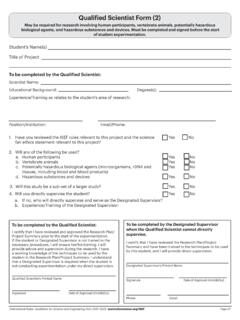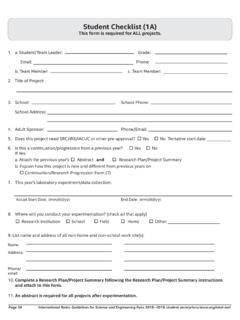Transcription of This completed form is required for ALL projects.
1 Checklist for Adult Sponsor (1). This completed form is required for ALL projects. To be completed by the Adult Sponsor in collaboration with the student researcher(s): Student's Name(s): Project Title: 1. I have reviewed the Intel ISEF Rules and Guidelines. 2. I have reviewed the student's completed Student Checklist (1A) and Research Plan/Project Summary. 3. I have worked with the student and we have discussed the possible risks involved in the project. 4. The project involves one or more of the following and requires prior approval by an SRC, IRB, IACUC or IBC: Humans Potentially Hazardous Biological Agents Vertebrate Animals Microorganisms rDNA Tissues 5. Items to be completed for ALL PROJECTS.
2 Adult Sponsor Checklist (1) Research Plan/Project Summary Student Checklist (1A) Approval Form (1B). Regulated Research Institutional/Industrial Setting Form (1C) (when applicable; after completed experiment). Continuation/Research Progression Form (7) (when applicable). Additional forms required if the project includes the use of one or more of the following (check all that apply): Humans, including student designed inventions/prototypes. (Requires prior approval by an Institutional Review Board (IRB);. see full text of the rules.). Human Participants Form (4) or appropriate Institutional IRB documentation Sample of Informed Consent Form (when applicable and/or required by the IRB). Qualified Scientist Form (2) (when applicable and/or required by the IRB).
3 Vertebrate Animals (Requires prior approval, see full text of the rules.). Vertebrate Animal Form (5A) - for projects conducted in a school/home/field research site (SRC prior approval required .). Vertebrate Animal Form (5B) - for projects conducted at a Regulated Research Institution. (Institutional Animal Care and Use Committee (IACUC) approval required prior experimentation.). Qualified Scientist Form (2) ( required for all vertebrate animal projects at a regulated research site or when applicable). Potentially Hazardous Biological Agents (Requires prior approval by SRC, IACUC or IBC, see full text of the rules.). Potentially Hazardous Biological Agents Risk Assessment Form (6A). Human and Vertebrate Animal Tissue Form (6B) - to be completed in addition to Form 6A when project involves the use of fresh or frozen tissue, primary cell cultures, blood, blood products and body fluids.
4 Qualified Scientist Form (2) (when applicable). The following are exempt from prior review but require a Risk Assessment Form 3: projects involving protists, archae and similar microorganisms, for projects using manure for composting, fuel production or other non-culturing experiments, projects using color change coliform water test kits, microbial fuel cells, and projects involving decomposing vertebrate organisms. Hazardous Chemicals, Activities and Devices (No SRC prior approval required , see full text of the rules.). Risk Assessment Form (3). Qualified Scientist Form (2) ( required for projects involving DEA-controlled substances or when applicable). Adult Sponsor's Printed Name Signature Date of Review (mm/dd/yy).
5 Phone Email International Rules: Guidelines for Science and Engineering Fairs 2018 2019, Page 29. Student Checklist (1A). This form is required for ALL projects. 1. a. Student/Team Leader: Grade: Email: Phone: b. Team Member: c. Team Member: _____. 2. Title of Project: 3. School: School Phone: School Address: 4. Adult Sponsor: Phone/Email: 5. Does this project need SRC/IRB/IACUC or other pre-approval? Yes No Tentative start date: _____. 6. Is this a continuation/progression from a previous year? Yes No If Yes: a. Attach the previous year's Abstract and Research Plan/Project Summary b. Explain how this project is new and di erent from previous years on Continuation/Research Progression Form (7). 7.
6 This year's laboratory experiment/data collection: Actual Start Date: (mm/dd/yy) End Date: (mm/dd/yy). 8. Where will you conduct your experimentation? (check all that apply). Research Institution School Field Home Other: _____. 9. List name and address of all non-home and non-school work site(s): Name: Address: Phone/. email 10. Complete a Research Plan/Project Summary following the Research Plan/Project Summary instructions and attach to this form. 11. An abstract is required for all projects after experimentation. Page 30 International Rules: Guidelines for Science and Engineering Fairs 2018 2019, Research Plan/Project Summary Instructions A complete Research Plan/Project Summary is required for ALL projects and must accompany Student Checklist (1A).
7 1. All projects must have a Research Plan/Project Summary a. Written prior to experimentation following the instructions below to detail the rationale, research question(s), methodology, and risk assessment of the proposed research. b. If changes are made during the research, such changes can be added to the original research plan as an addendum, recognizing that some changes may require returning to the IRB or SRC for appropriate review and approvals. If no additional approvals are required , this addendum serves as a project summary to explain research that was conducted. c. If no changes are made from the original research plan, no project summary is required . 2. Some studies, such as an engineering design or mathematics projects, will be less detailed in the initial project plan and will change through the course of research.
8 If such changes occur, a project summary that explains what was done is required and can be appended to the original research plan. 3. The Research Plan/Project Summary should include the following: a. RATIONALE: Include a brief synopsis of the background that supports your research problem and explain why this research is important and if applicable, explain any societal impact of your research. b. RESEARCH QUESTION(S), HYPOTHESIS(ES), ENGINEERING GOAL(S), EXPECTED OUTCOMES: How is this based on the rationale described above? c. Describe the following in detail: Procedures: Detail all procedures and experimental design including methods for data collection. Describe only your project. Do not include work done by mentor or others.
9 Risk and Safety: Identify any potential risks and safety precautions needed. Data Analysis: Describe the procedures you will use to analyze the data/results. d. BIBLIOGRAPHY: List major references ( science journal articles, books, internet sites) from your literature review. If you plan to use vertebrate animals, one of these references must be an animal care reference. Items 1 4 below are subject-specific guidelines for additional items to be included in your research plan/project summary as applicable. 1. Human participants research: a. Participants: Describe age range, gender, racial/ethnic composition of participants. Identify vulnerable populations (minors, pregnant women, prisoners, mentally disabled or economically disadvantaged).
10 B. Recruitment: Where will you find your participants? How will they be invited to participate? c. Methods: What will participants be asked to do? Will you use any surveys, questionnaires or tests? If yes and not your own, how did you obtain? Did it require permissions? If so, explain. What is the frequency and length of time involved for each subject? d. Risk Assessment: What are the risks or potential discomforts (physical, psychological, time involved, social, legal, etc.) to participants? How will you minimize risks? List any benefits to society or participants. e. Protection of Privacy: Will identifiable information ( , names, telephone numbers, birth dates, email addresses) be collected? Will data be confidential/anonymous?












